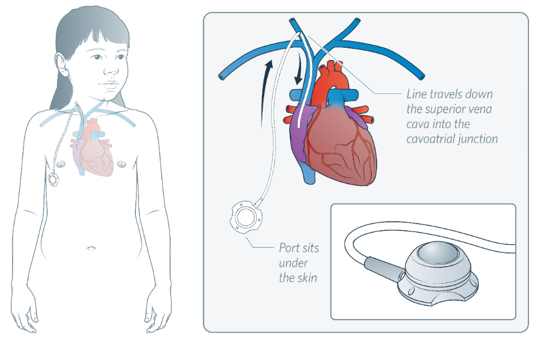What is a Central Venous Access Device (CVAD)?
A CVAD is a thin tube that is inserted into a vein, usually in the neck.
Why does my child need a CVAD and how long can it stay in for?
A CVAD is usually required when medication needs to be given for more than two weeks. A CVAD reduces the amount of needles that your child needs as it can also be used for blood tests. Depending on your child’s treatment, the CVAD may need to stay in place for months or years.
Is there more than one type of CVAD?
There are many types of CVADs. Depending on your child’s medical needs, the team will choose the best CVAD for your child.
Port
A port is a type of CVAD that is inserted into a vein in the neck with a rubber dome that sits under the skin.
When the port needs to be accessed, a special needle is
inserted through the skin and into to the rubber dome. The needle will be covered with a clear plastic dressing. When the port doesn’t need to be accessed, the needle will come out and only a small bump will be seen on the skin.
If the port needs to be accessed for more than one week, the needle will need to be changed every seven days. When the port is not being used, it will need to be flushed with fluid every four to six weeks to make sure it is working properly. This can be done in the hospital or in your home.
Totally Implanted
Venous Access Device (Port)

Common CVAD complications
One of the most common problems that happens with CVADs is a blockage inside the tube. This is usually caused by a small blood clot. Most of the time this can be fixed with medication that removes the clot. It takes between two to four hours for this medication to work and it needs to be given in hospital.
The team caring for your child’s CVAD will use a cleaning solution to keep the skin clean. However, germs can still get into the CVAD which may lead to an infection.
Care at home – preventing infection
If your child is discharged home and the needle is still in place (accessed):
It is important to keep giving your child a bath or shower as this stops germs on the skin. When bathing your child, make sure the dressing and tube remains clean and dry.
- If your child has a bath, you can use a piece of tape to hold the end of the tube to your child’s chest.
- If your child has a shower, any clean plastic covering can be used to help protect the dressing and tube from water, such as a plastic bag or cling film with tape securing the edges.
- Your child cannot go swimming while they have their port accessed.
- Make sure the end of the CVAD is kept away from nappies.
- Keep scissors or any other sharp objects away from your child’s CVAD.
When to seek medical attention
- If you are worried about your child’s condition, call an ambulance.
- Seek medical attention if you notice:
- Any redness or swelling near the port dome.
- If the needle has come out of the port.
- Chills or fever.
- If you have any worries about your child’s condition.
Key points to remember
- Make sure your child has a bath or a shower once a day and always wash your hands before and after touching the CVAD.
- Keep sharp objects away from your child’s CVAD.
- Seek medical attention, present to the emergency department, or call an ambulance if you are worried about your child’s condition.
For more information
Common questions our doctors get asked
Can my child play sport with a port?
When the port is not accessed, ask your child’s doctor about what activities your child can do. Many children can return to normal activity.
What are some tips for accessing the port?
- Apply a numbing cream over the port and cover with a plastic dressing one hour before the port needs to be accessed. Talk to your health care provider about what creams can be used.
- Comfort your child throughout the port access procedure. Some children like to be distracted by watching videos on a tablet device or playing games.
Developed by The Royal Children's Hospital CVAD Committee. We acknowledge the input of RCH consumers and carers.
Created December 2020.
Kids Health Info is supported by The Royal Children’s Hospital Foundation. To donate, visit
www.rchfoundation.org.au.